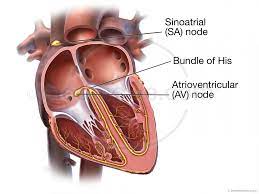
The bundle of HIS originates near the orifice of the coronary sinus, and undergoes slight enlargement to form the AV node.
The AV node tapers down into the bundle of His, which passes into the ventricular septum and divides into two bundle branches, the left and right bundles.
Sometimes the left and right bundles of His are called Purkyně or Purkinje fibers.
The bundle of His or His bundle is a collection of heart muscle cells specialized for electrical conduction.
As part of the electrical conduction system of the heart, it transmits the electrical impulses from the atrioventricular node, which is located between the atria and the ventricles to the point of the apex of the fascicular branches via the bundle branches.
The fascicular branches then lead to the Purkinje fibers, which provide electrical conduction to the ventricles, causing the cardiac muscle of the ventricles to contract at a paced interval.
The bundle of His transmits impulses from the atrioventricular node, located at the anterior-inferior end of the interatrial septum, to the ventricles of the heart.
The bundle of His branches into the left and the right bundle branches, which run along the interventricular septum.
The left bundle branch further divides into the left anterior fascicle and the left posterior fascicle.
These bundles and fascicles give rise to thin filaments known as Purkinje fibers.
These fibers distribute the impulse to the ventricular muscle.
The ventricular conduction system comprises the bundle branches and the Purkinje networks.
It takes about 0.03–0.04 seconds for the impulse to travel from the bundle of His to the ventricular muscle.
Disorders affecting the cardiomyocytes that make up the electrical conduction system are called heart blocks.
Heart blocks are separated into categories based on the location of the cellular damage.
Damage to any of the conducting cells in or below the bundle of His is referred to as “infra-Hisian blocks”.
Blocks that occur in the right or left bundle branches are called bundle branch blocks.
Blocks that occur in either the left anterior or the left posterior fascicles are called fascicular blocks, or hemiblocks.
The conditions in which both the right bundle branch and either the left anterior fascicle or the left posterior fascicle are blocked are collectively referred to as bifascicular blocks.
The condition in which the right bundle branch, the left anterior fascicle, and the left posterior fascicle are blocked is called trifascicular block.
Infra-hisian blocks limit the heart’s ability to coordinate the activities of the atria and ventricles, which usually results in a decrease in its efficiency in pumping blood.
His bundle pacing is more effective in producing synchronized ventricular contraction, and improving cardiac function than apical pacing.
